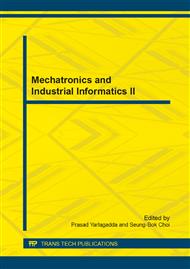[1]
Xianbo Xiang, Jouvencel Bruno, Parodi Olivier. Coordinated Formation Control of Multiple Autonomous Underwater Vehicles for Pipeline Inspection [J]. International Journal of Advanced Robotic Systems, 2010 (5) 75-84.
DOI: 10.5772/7242
Google Scholar
[2]
Ruilei Zhang, Sheng Li, Qingwei Chen. Dynamic Formation Control for Car-like Mobile Robots [J]. ROBOT, 2013, 35(6): 651-656.
DOI: 10.3724/sp.j.1218.2013.00651
Google Scholar
[3]
Balch T, Arkin R C. Behavior-based formation control for multi robot teams [J]. IEEE Transactions on Robotics and Automation, 1998, 14(6): 926-939.
DOI: 10.1109/70.736776
Google Scholar
[4]
Kar-Han Tan, Lewis M A. Virtual structures for high-precision cooperative mobile robotic control [C]. 1996 IEEE International Conference on Intelligent Robots and Systems. Osaka, Japan: IEEE, 1996: 132-139.
DOI: 10.1109/iros.1996.570643
Google Scholar
[5]
Fan W H, Liu Y H, Cai X P. Multi-robot formation control using potential field for mobile ad-hoc networks [C]. 2005 IEEE International Conference on Robotics and Biomimetics. Shatin, China: IEEE, 2005: 133-138.
DOI: 10.1109/robio.2005.246251
Google Scholar
[6]
Desai J, Ostrowski J, Kumar V. Modeling and control of formations of nonholonomic mobile robots [J]. IEEE Transactions on Robotics and Automation, 2001, 17(6): 905-908.
DOI: 10.1109/70.976023
Google Scholar
[7]
Kowdiki K H, Barai R K, Bhattacharya S. Leader-follower formation control using artificial potential functions: A kinematic approach [C]. 2012 International Conference on Advances in Engineering, Science and Management. Nagapattinam, Tamil Nadu: IEEE, 2012: 500-505.
Google Scholar
[8]
Consolini L, Moribidi F, Prattichizzo D, et al. A geometric characterization of leader-follower formation control [C]. 2007 IEEE International Conference on Robotics and Automation. Roma, Italy: IEEE, 2007: 2397-2402.
DOI: 10.1109/robot.2007.363678
Google Scholar
[9]
Wei Ren. Consensus tracking under directed interaction topologies: Algorithms and experiments [J]. IEEE Transactions on Control Systems Technology, 2010, 18(1): 230-237.
DOI: 10.1109/tcst.2009.2015285
Google Scholar
[10]
Wei Ren, Nathan S. Distributed coordination architecture for multi-robot formation control [J]. Robotics and Autonomous Systems, 2008, 56(4): 324-333.
DOI: 10.1016/j.robot.2007.08.005
Google Scholar


